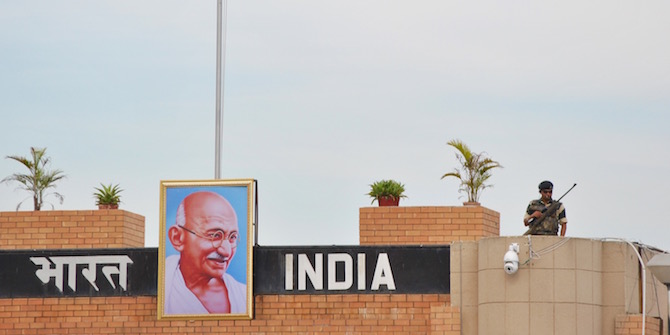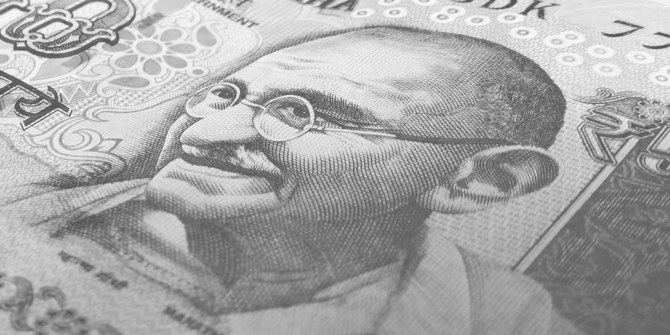Ending the civil war, bringing lasting peace to Kachin State and achieving peace were key campaign promises in 2015 of Aung San Suu Kyi and the National League for Democracy (NLD). With the 2020 election just over a year away their window of opportunity is quickly closing. Stella Naw (Civil Rights Defenders) outlines what the NLD government and the international community can do to end the Kachin conflict.
 Photo: A grandson and grandmother digging bomb bunker in an IDP camp in a KIO-administered area, Myanmar. Credit: Hkun Li
Photo: A grandson and grandmother digging bomb bunker in an IDP camp in a KIO-administered area, Myanmar. Credit: Hkun Li
Hidden in the mountains of northern Burma lies the resource rich land of the Kachin. Generations of Kachin people have experienced political, cultural, religious and economic oppression at the hand of the Burma Military (BM) also called Tatmadaw. Kachin State has been the site of armed conflict for more than five decades with the BM waging war for a greater control over the state and the Kachin Independence Organization/Kachin Independence Army (KIO/KIA) struggling for self-determination. The 1994 ceasefire agreement between the KIO and BM held for 17 years prior to the resumption of fighting in June 2011 when the BM attacked a KIA outpost at San Gang. Over the last eight years of war 367 villages and 272 churches have been destroyed, and there are currently over 100,000 internally displaced people in Kachin and northern Shan States. The KIO has been involved in peace talks around the “Nationwide Ceasefire Agreement” (NCA), but has declined to become a signatory.
Despite attempts at rebranding it as the “21st Century Panglong,” since 2016 the NLD government has essentially continued along the NCA path designed by the previous quasi-civilian government. There has been no substantive progress after three years.
The problem is that the NCA is being presented as the only path to achieve peace. The NLD government must look beyond the limited NCA structure and engage in activities that build trust among the Kachin people and all ethnic populations.
Origins of the Kachin Conflict
The ceasefire negotiations are nothing new in Kachin State. Since the creation of the KIO in 1961, the organisation has had four rounds of significant ceasefire negotiations with the BM, none of which resulted in lasting peace. This experience has made the KIO hesitant to sign yet another ceasefire agreement without assurances that genuine political dialogue will take place.
The KIO signed the 1994 ceasefire agreement with the understanding that a political dialogue process would follow. It did not. In 2005 the KIO was asked to provide input into the National Convention to draft the constitution, however none of the 19 points submitted by the KIO were included in the 2008 Constitution.
It was the BM who broke the 1994 ceasefire agreement in June 2011 after the KIO refused to transform itself into a Border Guard Force (BGF). The BM’s vision to resolve decades of armed conflict was to transform EAOs into subservient paramilitary units. Some groups accepted the BGF offer (which included business concessions) but the KIO rejected it since it was not going to bring political solutions. For the KIO the choice to take up arms has only ever been a means to an end; a way to find political solutions to the challenges faced by the Kachin people.
In 2013, despite facing military offensives by the BM including air strikes, the KIO decided to engage in the NCA process to seek peace once again. After two years of negotiations, several EAOs signed the NCA but the KIO declined demanding “inclusivity” as the BM blocked the participation of some EAOs. In return, there was an intensification of military offensives on KIA posts and a targeting of Kachin civilians as a form of collective punishment.
Beyond closed door diplomacy
The international community should use its diplomacy and engagement to publically encourage the NLD government and BM to immediately allow full access for the delivery of humanitarian relief to IDP camps in KIO-administered territories, and repeal unjust laws such as the Unlawful Association Act being used to collectively punish Kachin people.
Since May 2016, Aung San Suu Kyi’s government has continued the BM’s policy of blocking the delivery of humanitarian aid to IDPs living in KIO-administered areas because the aid would be used by the KIA. The same argument is not made for IDP camps in Union Government and Military-controlled areas. It is the most vulnerable who are being hurt by this blockade.
A former international aid worker to Kachin State told me, “the ultimate impact being that civilians are suffering, international humanitarian and human rights laws continue being breached with disregard. Actors are at wits end with the UN, diplomatic community, and most INGOs failing to effectively address the severity of the situation.”
On the other side of the 900-km Kachin State–China border, the well-being of IDPs living in KIO-administered areas is dependent on the continued ability to move goods including humanitarian relief aid across the border. In what is possibly an exchange for protection and expansion of its geopolitical interests and investments in Burma, Chinese officials have recently threatened Kachin religious leaders that humanitarian aid passing through China would be blocked if they continue to oppose the Myitsone dam project and the NCA.
At the same time, it is common for people travelling into KIO-administered areas to be harassed and detained under the colonial era Unlawful Association Act. Anyone, including humanitarian aid workers from faith-based organisations, journalists, IDPs and regular Kachin civilians, may be detained and imprisoned under this law.
A massive amount of foreign money has flooded into Burma for humanitarian relief, development assistance and to support the peace process. For example, the European Union has committed over €1 billion to Burma from 2007 to 2020. The lion’s share of this international money goes to or supports central government approved initiatives. Existing social infrastructure and institutions in ethnic areas, which have for decades served ethnic communities ignored by the central government, are being sidelined.
It is no secret that serious human rights violations are regularly perpetrated with impunity in Kachin state. The UN-mandated Fact Finding Mission’s (FFM) September 2018 report stated “The crimes against humanity committed in Kachin, Shan and Rakhine States include murder; imprisonment; enforced disappearance; torture; rape, sexual slavery and other forms of sexual violence; persecution and enslavement.” The comprehensive documentation presented in the FFM report sheds light on what the Kachin community has endured at the hand of BM for decades, and raises the possibility for justice. Yet, some members of the international community see accountability as an unnecessary component during Burma’s transition due to the continuing dominance of the Military institution in government, the judiciary and all sectors of the economy. The Japanese Ambassador made the case, rarely stated outright, for turning a blind eye to accountability and justice, stating: “We want to see Myanmar stable and developed, but if we were to take action against the Tatmadaw—which constitutes one of the important sectors of the country—there will be no hope of seeing that stability and development.”
Any country that wants to see a successful transition in Burma must support an independent investigative mechanism for achieving reconciliation through accountability and justice. Only with an ultimatum to walk a reconciliatory path will there be a new beginning in which people know that their basic rights are protected and that they will not be punished for their ethnicity or religion.
No time to lose
The NLD made “peace” a top campaign promise in the 2015 general election. Despite this, the situation has worsened, with northern Shan and Kachin States experiencing the heaviest fighting and largest number of displaced people in decades. If the NLD wants to show some success before the November 2020 election there will need to be a new strategy to achieve peace.
Firstly, the NLD government should call on the BM to start a unilateral ceasefire, as this would create trust with EAOs. Whether or not the BM listens, the NLD government must make its stance for peace very clear.
The NLD should start holding substantive political dialogues with the KIO together with representatives of Kachin civil society including the people whose lives are directly impacted by the war especially women and IDPs. Treat such meetings as a convergence for trust-building and use the opportunity to learn about the challenges of the Kachin community and their political vision for a future federal state, rather than simply to exert pressure to sign the NCA.
The people appointed by the NLD to lead the peace process must have experience and competencies, not simply be loyal to Aung San Suu Kyi. As representatives of the democratically elected government, NLD appointees must use their authority to direct the process and make decisions. All too often it has been the BM appointees who end up taking charge and making key decisions.
To date the BM has prohibited the discussion of security sector reform (SSR) stating that only disarmament, demobilisation and reintegration (DDR) may be discussed in peace talks. This linguistic struggle between DDR and SSR is symbolic of fundamentally differing visions of the peace process,. The BM wants disarmament of non-state groups prior to substantive political dialogue (what journalist and author Bertil Lintner has called “putting the cart before the horse”). The EAOs are calling for a wider-reform of Burma’s military structure, specifically the inclusion of EAO officers in command positions and placing the Military under control of the civilian government. The popularly elected NLD government can no longer allow the BM to dictate the limits of peace negotiations. The NLD must ensure that discussion of SSR is on the agenda to begin the political discussion.
The NLD must ensure that the peace process includes a clear mechanism to achieve reconciliation through accountability and justice for human rights violations perpetrated during the decades of conflict.
Lastly, Aung San Suu Kyi has a rare opportunity to restore the trust of the people who voted her into office by cancelling China’s $3.6 billion Myitsone dam project on the Irrawaddy River. Opposition to this project has united people from all walks of life across Burma. This is a situation where the NLD should stand behind the people to do the right thing by saving the Irrawaddy. As Daw Nyo Nyo Thinn, a former MP, rightly pointed out, “People didn’t elect Aung San Suu Kyi and the NLD in order to continue agreements made by her predecessor but to do things differently for the long term well-being of the people.”
This article gives the views of the author and not the position of South Asia @ LSE blog, nor of the London School of Economics. Please read our comments policy before posting.
Stella Naw is Programme Officer of Civil Rights Defenders (@crdefenders). She tweets @stellanaw.







